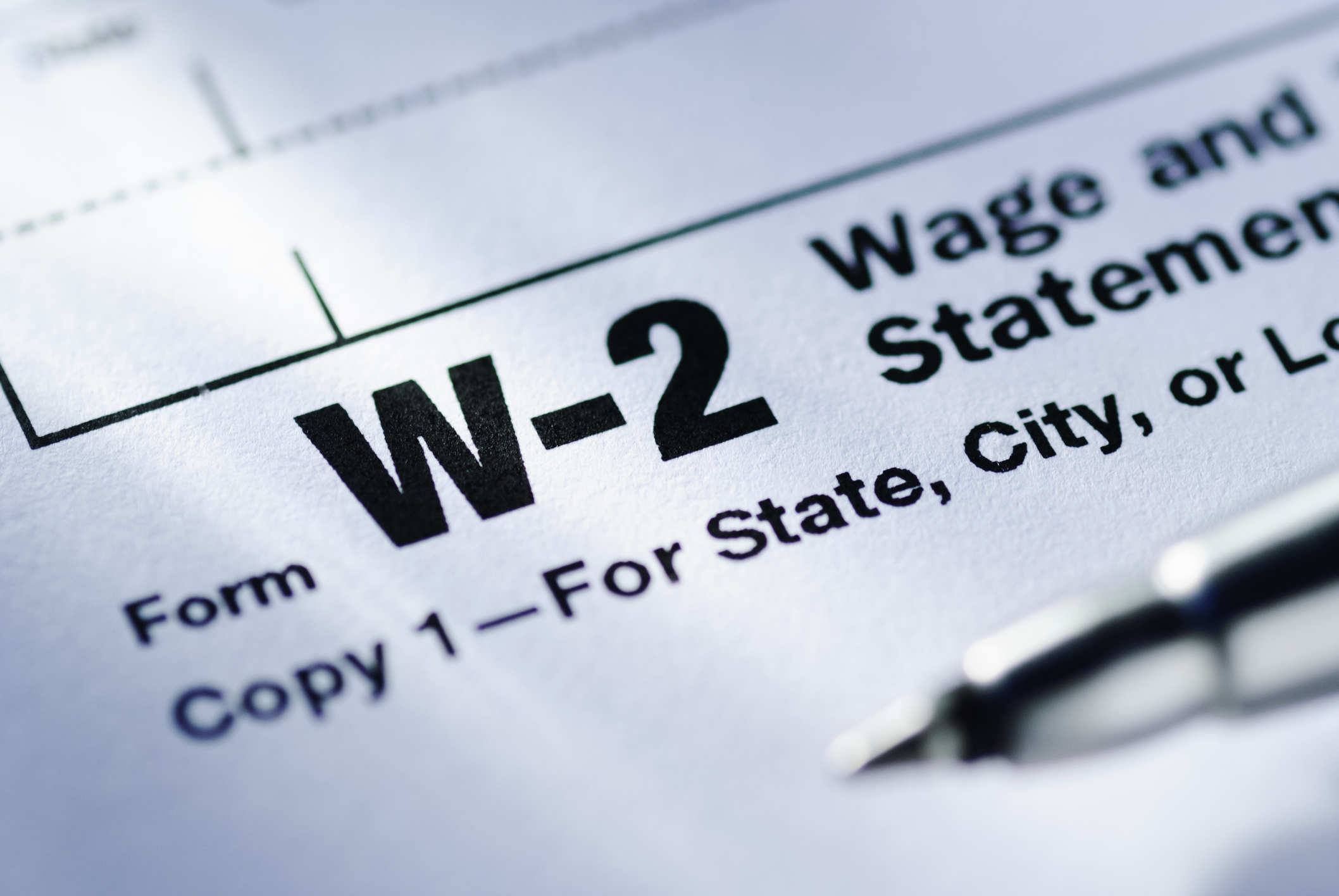Tax Scam: IRS Warns Taxpayers Against Filing False W-2 Info
Latest social media scam advises lying on your W-2 to falsely claim credits and bigger refunds.


Tax season brings tax scams like night follows day. And with all the advice circulating on the internet, it can be hard to separate the good from the bad. The IRS has recently flagged a particularly pernicious W-2 "tax hack" which encourages people to claim unearned credits and bigger tax refunds by lying about their income. Here's the breakdown of this bad idea and the legal consequences for any taxpayer unwise enough to try it.
The W-2 tax scam means lying to the IRS
The IRS is warning taxpayers about a scheme flying around on social media that advises manually altering your W-2 form to add false wage data. Scammers are advising people to invent larger-than-life withholding figures, as well as fake employers, before electronically filing the false return to obtain a giant refund. The standard deduction just isn't enough for some people, apparently.
The IRS, state tax authorities, and tax industry firms are monitoring a variety of tax schemes as Tax Day approaches. The IRS coordinates the Social Security Administration, major employers and payroll companies like ADP to review W-2 information. So if you think you can slip fake job information through the net, think again.

Sign up for Kiplinger’s Free E-Newsletters
Profit and prosper with the best of expert advice on investing, taxes, retirement, personal finance and more - straight to your e-mail.
Profit and prosper with the best of expert advice - straight to your e-mail.
Tax authorities are tracking two variants of the W-2 scheme that misuse wage info to generate a big, unearned refund.
The first type of tax scam involves filing Form 7202, Credits for Sick Leave and Family Leave for Certain Self-Employed Individuals. Scammers advise people to claim this credit for the income they earned as regular employees — rather than the intended self-employed taxpayers. These pandemic-specific credits are no longer available for use on 2022 tax returns, anyway. Trying to claim expired COVID emergency credits for the self-employed will certainly get your return flagged.
The second version of the W-2 scam is even more creative: advising taxpayers to make up fake household employees. Scammers recommend claiming hefty tax refunds for falsified family and for sick wages they never actually paid, using Schedule H (Form 1040), Household Employment Taxes. The form is designed to report household employment taxes if a taxpayer hired someone to do household work. It's not intended for making up fake employees and claiming unearned refunds.
Legal consequences of the W-2 scam
The IRS reminds people who try the W-2 scam, or any other tax fakery, that they face a wide range of financial and legal consequences. The most likely penalty is the frivolous return penalty, of $5,000.
An Erroneous Claim for Refund or Credit penalty could also apply. This penalty covers any claims for refunds or income tax credits for an excessive amount without reasonable cause. This could be up to 20% of the excessive amount claimed, so if you claimed a $20K refund, you would be penalized $4,000 for your false claim.
Filers also run the risk of criminal prosecution for filing a false tax return. In similar cases taken to trial, a single felony charge carried a sentence of up to three years in prison, a $100,000 monetary fine, and a year of supervised probation.
How to fix a false tax return
If you or anyone you know has participated in this W-2 scheme, the IRS recommends filing an amended tax return. You could also consider consulting a tax professional to get your ducks fully in a row.
Here's what to know about amended returns:
- If your filing deadline and available tax extensions haven't passed, file a "superseding return." If you file a second return before the filing deadline, the second return "supersedes" the first return and is treated as the original return.
- The IRS can correct most simple errors for you, but substantial income changes require an amended return.
- When filing an amended return, you'll probably need to submit IRS Form 1040X, which is used to:
- Correct Forms 1040, 1040-SR, or 1040-NR;
- Make certain elections after the election deadline;
- Change amounts previously adjusted by the IRS (except IRS changes to interest or penalties); or
- Claim a loss or unused credit carryback.
- You can electronically file amended Forms 1040, 1040-SR and 1040-NR for any tax year after 2018.
- You must file an amended tax return within three years from the date you filed your original return or within two years from the date you paid any tax due, whichever is later.
- Track the status of your amended tax return via the "Where's My Amended Return?" tool or by calling 866-464-2050.
A tax pro can offer more detailed advice on how to get right with the IRS. Look up credentialed tax preparers in your area, using resources like the IRS’s online Directory of Federal Return Preparers. Once you find a few you like, ask them directly for their credentials and consider checking their history and reputation via resources like the Better Business Bureau. Avoid tax preparers that take a percentage of your refund or refuse to sign your return before filing.
Related Content
- When Are Taxes Due in 2023? Tax Deadlines by Month
- What Are the Income Tax Brackets for 2023 vs. 2022?
- Biden Wants a Wealth Tax: Should Billionaires Pay More?
- Powerball Winner Will Pay Some Hefty Taxes
- Scams Cost Consumers $8.8 Billion in 2022 - The Top 5 Frauds
Get Kiplinger Today newsletter — free
Profit and prosper with the best of Kiplinger's advice on investing, taxes, retirement, personal finance and much more. Delivered daily. Enter your email in the box and click Sign Me Up.

Ben Demers manages digital content and engagement at Kiplinger, informing readers through a range of personal finance articles, e-newsletters, social media, syndicated content, and videos. He is passionate about helping people lead their best lives through sound financial behavior, particularly saving money at home and avoiding scams and identity theft. Ben graduated with an M.P.S. from Georgetown University and a B.A. from Vassar College. He joined Kiplinger in May 2017.
-
 Stock Market Today: Stocks Gain on Tech, Auto Tariff Talk
Stock Market Today: Stocks Gain on Tech, Auto Tariff TalkThe Trump administration said late Friday that it will temporarily halt tariffs on some Chinese tech imports.
By Karee Venema
-
 Sam's Club Plans Aggressive Expansion: Discover Its New Locations
Sam's Club Plans Aggressive Expansion: Discover Its New LocationsSam's Club expansion plans will open up to 15 new stores each year. Learn where they plan to open in 2025.
By Sean Jackson
-
 Tax Time: Does Your Kid Influencer Owe Taxes?
Tax Time: Does Your Kid Influencer Owe Taxes?State Tax Some minors are making big money on social media. Here’s how to know if they need to file taxes.
By Gabriella Cruz-Martínez
-
 Ask the Editor: Readers' Tax Questions, April 11, 2025
Ask the Editor: Readers' Tax Questions, April 11, 2025Ask the Editor: Taxes, April 11, 2025 — Joy Taylor, The Kiplinger Tax Letter Editor, answers questions on Roth IRAs, RMDs and other retirement accounts.
By Joy Taylor
-
 Free IRS Tax Filing for 30 Million People: Will It Continue Under Trump?
Free IRS Tax Filing for 30 Million People: Will It Continue Under Trump?Tax Filing Direct File was piloted last year in 12 states and has since expanded to 25. But some wonder whether the program will last under the Trump administration.
By Gabriella Cruz-Martínez
-
 Taxpayer Revolt? Why More People Are Avoiding Filing Taxes This Year
Taxpayer Revolt? Why More People Are Avoiding Filing Taxes This YearTax Season It may be tempting to skip filing due to the overwhelmed IRS, but doing so could have financial and legal consequences.
By Kelley R. Taylor
-
 U.S. Treasury to Eliminate Paper Checks: What It Means for Tax Refunds, Social Security
U.S. Treasury to Eliminate Paper Checks: What It Means for Tax Refunds, Social SecurityTreasury President Trump signed an executive order forcing the federal government to phase out paper check disbursements by the fall.
By Gabriella Cruz-Martínez
-
 IRS Layoffs Spark Delays, Doubt This Tax Season
IRS Layoffs Spark Delays, Doubt This Tax SeasonTax Season Tax experts say Trump’s downsizing of the IRS is already causing problems.
By Gabriella Cruz-Martínez
-
 DOGE Gains More Grip on IRS Amid Leadership Reshuffle
DOGE Gains More Grip on IRS Amid Leadership ReshuffleIRS The IRS acting chief counsel was recently removed from his role, adding to the chaos at the federal tax agency. Here’s what it means for you.
By Gabriella Cruz-Martínez
-
 Trump’s Latest Pitch: No Taxes If You Earn Less Than $150K?
Trump’s Latest Pitch: No Taxes If You Earn Less Than $150K?Taxes The Trump administration reportedly wants to eliminate taxes for certain earners.
By Gabriella Cruz-Martínez